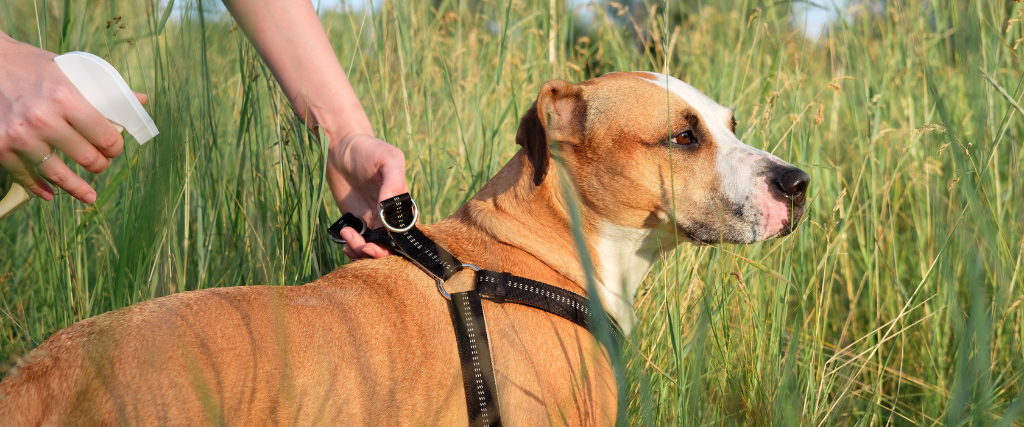If you were to meet Howie with his cute bow tie and his wagging tail, you would never know that one fateful day last spring his mother thought he was on death’s doorstep. When Howie arrived at the clinic he was painful to the touch, had a high fever, had no appetite, and was very lethargic. He had no desire to walk around and we could barely touch him without him yelping in pain. After carefully examining him, our top two differentials were a back issue or Lyme disease. Howie’s owner remembered that Howie had tested Lyme positive at his previous vet a couple of years ago. Since in-house testing shows exposure and not necessarily an active infection, the positive result was confirmed at an outside lab by measuring the Lyme levels in Howie’s blood. Howie was treated with medication and has happily made a full recovery much to everyone’s relief.
Howie was lucky that his Lyme disease presented as soreness with a fever. Although this is probably one of the more common presentations in dogs along with lameness, did you know it can also cause very serious kidney issues as well?

Important Facts About Lyme Disease?
Lyme disease is a bacterial infection known as Borrelia burgdorferi which is spread by the black-legged tick (also known as the deer tick). It was first recognized in 1975 when researchers started investigating why so many children were developing juvenile rheumatoid arthritis in Lyme, Connecticut, and several surrounding towns. There is evidence that Lyme disease was present in wildlife all the way back to the late 1800s. Even though we think of deer carrying the deer tick into our backyards, other wildlife such as mice, foxes, raccoons, squirrels, etc. can also help these unwanted ticks get where they want to go.
Most people mistakenly think that if they don’t see ticks or if their dog has short hair their dog is safe. This is not true. Deer ticks can be the size of a pin head and can quickly and easily attach to a short hair, a light-colored dog without ever being detected. After the deer tick attaches, if the tick is carrying Borrelia burgdorferi, it will begin transmitting the bacteria to your dog while it eats its blood meal. On average it takes 24-48 hours for the tick to pass Lyme disease to your dog.
Lyme disease presents itself in dogs in several ways. Your dog may contract the disease but never show clinical signs, or they may get a fever, have swollen or painful joints, shifting leg lameness, stiffness, lethargy, or anorexia. In extreme cases (and unfortunately we’ve seen several of these) Lyme disease can go to the kidneys and result in often fatal kidney failure.
Does My Dog Have Lyme Disease?
So how can you tell if your dog has Lyme disease? Take your dog to the vet! You may suspect Lyme disease in your dog if you see some of the above-mentioned signs, but most of those clinical signs can be related to other non-Lyme-related diseases as well. Cincinnati Family Vet recommends testing dogs annually for Lyme disease using a test that looks for heartworm disease, Lyme disease, Anaplasmosis, and Ehrlichia. The last three are all tick-borne diseases seen in the Cincinnati area.
So what does a positive result mean, and what do you do about it? If your dog tests positive it doesn’t necessarily mean that your dog needs to be treated. If your dog tests positive it means that he has been exposed to the disease. What your veterinarian does with that positive result will vary. Your veterinarian may recommend checking your dog’s urine for protein, which can be an early sign of Lyme disease affecting the kidneys. They may recommend sending out additional blood work to a laboratory to test how high the Lyme levels are and whether your dog should be treated, or your veterinarian may decide to monitor your dog for clinical signs of Lyme disease and treat only if clinical signs present.

How Do I Prevent Lyme Disease In My Dog?
The most important thing you should ask yourself is how do you prevent Lyme disease? This is a twofold answer. First talk to your veterinarian about the Lyme vaccine. This vaccine is strongly recommended in dogs that spend time outdoors since they are more likely to be exposed to ticks and therefore Lyme disease. However, the vaccine is not 100% effective, so to help give your dog the best chance of not contracting Lyme disease you should also use flea and tick prevention. Not all flea and tick preventatives are created equal. You want something that will repel ticks or kill them before the 24-hour mark when they attach (remember it takes 24-48 hours to transmit Lyme disease). It’s often tempting to purchase something you see at the store, but we strongly recommend consulting with your veterinarian for the best flea and tick prevention for your pet. Since there are so many choices out there, tap into your veterinarian’s knowledge before making a decision!
Even though Lyme disease is well known to people who live in this area, it’s important to remember to protect not only yourself but your dog as well. This means using appropriate tick preventatives, vaccination, and testing. Just because you don’t see a tick or your dog has no clinical signs of Lyme disease doesn’t mean they don't have it. It’s better to be proactive and take steps to prevent Lyme disease or minimize it than to watch your best friend suffer from the clinical signs of the disease.
We are happy to report over a year later Howie is doing wonderfully. It’s possible his Lyme disease will rear its ugly head again; but through careful annual monitoring, we will hopefully prevent that from happening again.


